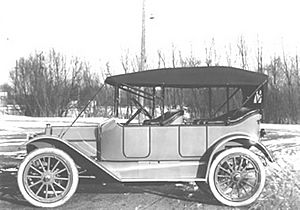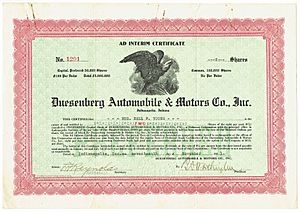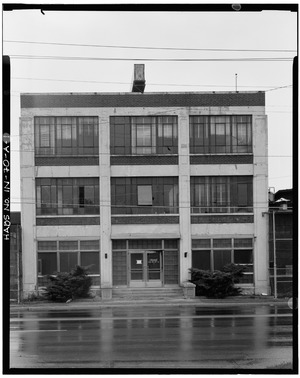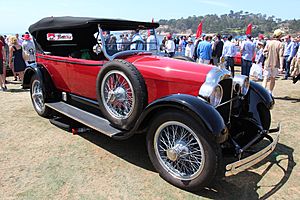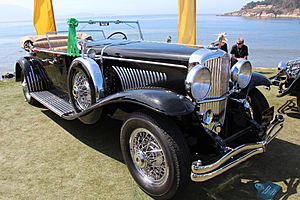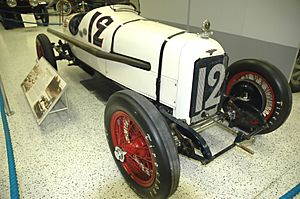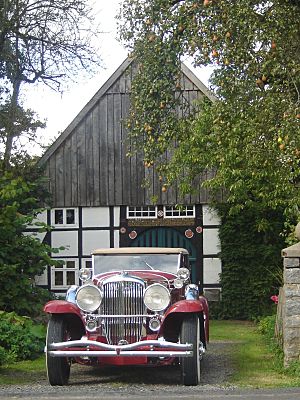Fred Duesenberg facts for kids
Quick facts for kids
Frederick Samuel Duesenberg
|
|
|---|---|

Fred Duesenberg in 1925
|
|
| Born |
Friedrich Simon Düsenberg
December 6, 1876 |
| Died | July 26, 1932 (aged 55) Johnstown, Pennsylvania, U.S.
|
| Nationality | American |
| Occupation | Early automobile designer, manufacturer, racer |
| Known for | Duesenberg automobile |
| Awards | Motorsports Hall of Fame |
Frederick Samuel Duesenberg (born December 6, 1876 – died July 26, 1932) was a famous American car and engine designer. He was born in Germany but moved to the United States. Fred Duesenberg was known around the world for designing amazing racecars and powerful engines. His ideas greatly changed how cars were built, especially in the 1910s and 1920s.
He was one of the first to introduce an eight-cylinder engine, called the Duesenberg Straight-8 engine. He also brought four-wheel hydraulic brakes to American cars, which was a big step forward! Fred and his younger brother, August "Augie" Duesenberg, held patents for many of their designs. These included their special "walking beam" engine and the Straight 8 engine.
In 1913, the Duesenberg brothers started the Duesenberg Motor Company. Later, in 1920, they helped create the Duesenberg Automobile and Motor Company in Indianapolis, Indiana. This company made luxury cars from 1921 to 1937. Their first car made for many people was the Duesenberg Model A. Fred Duesenberg was the main engineer for both companies. From 1926 until he died in 1932, Fred focused on designing super fancy cars like the Duesenberg models X, S, and J. He was also the company's vice president of engineering and later its president. Fred Duesenberg passed away in 1932 after a car accident. The company stopped making Duesenberg passenger cars five years later.
Fred and Augie Duesenberg were also very involved in car racing for over ten years. Even though Fred stopped driving racecars by 1912, he continued to design them and own racing teams for another twelve years. In 1920, a Duesenberg racecar driven by Tommy Milton set a new land-speed record of 156.046 miles per hour (251.132 km/h) at Daytona Beach, Florida. In 1921, Jimmy Murphy drove a Duesenberg racer to win the famous Grand Prix race in Le Mans, France. This was the first time an American car won that race! Duesenberg cars also raced in the Indianapolis 500 between 1912 and 1932. They won the race at the Indianapolis Motor Speedway in 1924, 1925, and 1927. Fred Duesenberg stopped racing in 1931.
Contents
Early Life and Learning About Cars
Friedrich "Fred" S. Düsenberg was born on December 6, 1876, in Lippe, Germany. His name was later spelled Frederick "Fred" Duesenberg when he came to the United States. Fred and his younger brother, August "Augie" Samuel Düsenberg, were the youngest of seven children.
Fred's father died in 1881. His older brother, Henry, moved to America in 1884. In 1885, Fred's mother sold their farm in Germany and brought her other children, including Fred, to the United States. They joined Henry in Iowa. The family settled on a farm in Floyd County, Iowa, near Rockford.
Fred Duesenberg was good with machines from a young age. He went to school until eighth grade. He also took a course by mail to learn mechanical drafting. Most of his amazing engineering and car-building skills came from working with his hands. He learned by fixing farm machines and windmills near his home in Iowa. When he was young, Fred also enjoyed bicycle racing.
Family Life
Fred married Isle "Mickey" Denney on April 27, 1913. They had a son named Denny. Denny later became involved in car racing after Fred stopped racing in 1931.
Building a Career in Cars
Starting in the Car Industry
Fred and his brother, Augie, started by building and racing bicycles in Iowa in the 1890s. They also began trying out engines that ran on gasoline. Around 1900, the brothers designed their own engine and built motorcycles. After working at a garage, they opened a bicycle repair shop.
In 1903, Fred left to work for the Thomas B. Jeffery Company, which made Rambler bicycles and early cars. A year later, Fred returned to Iowa. He opened a garage with a friend and sold Rambler cars. Through his repair business, Fred met Edward Mason, a lawyer who helped fund Fred's idea for a two-cylinder car.
The Mason Motor Car Company started making cars in 1906. Fred was the superintendent and designer. Augie made the patterns for parts. When F. L. Maytag, who later became famous for washing machines, bought most of the company, it became the Maytag-Mason Motor Company in 1909. They made cars in Waterloo, Iowa. Besides a two-cylinder model, they also made cars with Fred's patented four-cylinder engine. This engine was simple, powerful, and reliable.
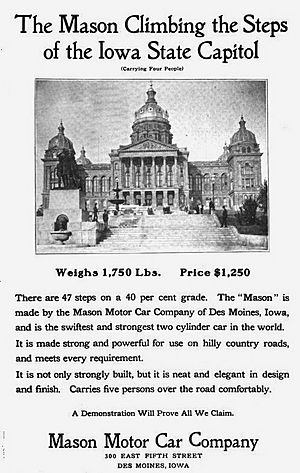
Fred often showed how strong his cars were. For example, he once drove a car up the steps of the Iowa State Capitol building! He also learned from his bicycle racing days that racing cars helped sell them. So, the Duesenberg brothers started entering their cars in races.
Maytag and Mason were new to making cars, and the company eventually closed. Fred left in 1910 to focus on racing and engine designs in his shop. Around 1910, Fred and Augie started working on their "walking beam" four-cylinder engine. Later, they created the Duesenberg straight-eight engine. They shared the patents for both engines. In 1913, the Duesenbergs moved to Saint Paul, Minnesota. There, they kept developing racecars and engines for cars and boats. In June 1913, they also started the Duesenberg Motor Company.
Early Car Races
The Duesenberg brothers had raced bicycles and motorcycles, so they naturally got into car racing. Fred won his first car race at the Iowa State Fair. In 1907, he crashed his test car and broke his shoulder. By 1912, he stopped driving racecars himself. However, he stayed active for another twelve years as a racecar designer and team owner.
Like other car builders, the Duesenbergs used the Indianapolis Motor Speedway to test and race their cars. Fred Duesenberg's cars raced in the Indianapolis 500 between 1912 and 1932. Their first appearance was in 1912, but their car broke down before the race. Between 1913 and 1916, the Duesenberg racing team got better. They finished ninth in 1913. In 1914, Eddie Rickenbacker, who later became a World War I flying hero, drove a Duesenberg-powered car to finish tenth. In 1915, the team took fifth and seventh places. In 1916, a new driver named Wilbur D'Alene finished in second place, their best result yet! When World War I started, car companies focused on making things for the war, and racing at the Indianapolis Motor Speedway stopped for two years.
Designing Engines for World War I
In 1917, the Duesenberg Motor Company joined with another company to form the Duesenberg Motor Corporation. Fred Duesenberg was the chief engineer, and Augie was his assistant. They made a deal to build car and airplane engines for the American, British, Italian, and Russian governments during World War I. The Duesenberg brothers moved to New York City in 1917 to oversee a new factory in Elizabeth, New Jersey. This factory was built just for making aviation and marine engines. Working with Ettore Bugatti's airplane engines gave the Duesenberg brothers new ideas. This helped them improve their Duesenberg Straight-8 engine, which was an eight-cylinder engine with a special overhead camshaft.
After the war, the Duesenberg brothers left New Jersey. They wanted to focus on building racecars from a rented space in Newark, New Jersey. In 1919, the Duesenberg Motor Corporation was sold. The brothers then focused completely on their racing business. In 1920, the Duesenberg brothers moved to Indianapolis, Indiana. There, the new Duesenberg Automobile and Motors Company planned to make passenger cars.
Designing Luxury Cars in the 1920s
While still working on racing engines, the Duesenberg brothers and their financial supporters started the Duesenberg Automobile & Motors Company in March 1920. Its main office was in Indianapolis. Fred was the chief engineer and later became president of the company. Augie was the assistant engineer. Starting in May 1921, the Duesenberg company made passenger cars with advanced racing features. Their new factory was in Indianapolis, close to the Indianapolis Motor Speedway, which they used for testing.
The first Duesenberg passenger car was shown in New York in late 1920. This new car had an "inline eight-cylinder overhead cam engine and four-wheel hydraulic brakes." This was a first for American cars! The Duesenberg Model A, their first car made for many people, was built between 1921 and 1927. However, the Model A wasn't very popular. It cost a lot (US$8,500 just for the frame!) and didn't look very stylish. Because of this, the company had money problems.
The company struggled financially and even went into a type of bankruptcy in 1924, but it recovered in 1925. A year later, E. L. Cord, who was the president of the Auburn Automobile Company, bought the Duesenberg company in 1926. Cord loved the Duesenberg Model A and wanted to make even faster and fancier "supercars."
Fred Duesenberg was given the job of designing these new luxury cars. From 1926 until his death in 1932, Fred focused on designing passenger cars like the X, S, and J models. He was the vice president of engineering at Duesenberg, which was now part of Cord's company. While Fred worked on these luxury cars, his brother, Augie, managed the Duesenberg Brothers racing business.
In October 1926, E. L. Cord announced that he wanted to offer "the finest thing on four wheels." He said Duesenberg cars would be custom-built, meaning buyers could choose their own styles and colors. The price would be around US$18,000, and they could go up to 120 miles per hour (190 km/h)! Early in 1927, Fred Duesenberg received an award for his important work in car engineering.
The Duesenberg Model J, announced in late 1928, was the new luxury car E. L. Cord wanted. Production started in the spring of 1929. Cord wanted the Model J to be bigger and heavier. Fred Duesenberg designed the car, making it incredibly powerful. These luxury cars started at US$13,500 and later cost US$18,000 or more. They had a 32-valve engine that could make 265 horsepower and reach a top speed of 115 miles per hour (185 km/h).
Later Car Racing Successes
Even though the Duesenberg team had problems in the 1919 Indianapolis 500 race, they had much more success in the 1920s. Several Duesenberg-designed racecars set speed records before Fred officially stopped racing after the 1931 Indianapolis 500. In April 1920, a Duesenberg racecar driven by Tommy Milton set a land-speed record of 156.046 miles per hour (251.132 km/h) at Daytona Beach, Florida. In August 1920, Fred and Augie Duesenberg formed Duesenberg Brothers, a separate company just for their racing business. In 1921, Jimmy Murphy drove a Duesenberg racecar to become the first American car to win the famous Grand Prix race in Le Mans, France.
Fred Duesenberg also designed the engines for the Duesenberg racecars that won three Indianapolis 500-mile races:
- The 1924 race with driver Lora L. Corum.
- The 1925 race with driver Pete DePaolo. This Duesenberg car was the first Indianapolis 500 winner to average over 100 miles per hour (160 km/h)!
- The 1927 race with George Sanders driving a Duesenberg-built car.
The Duesenberg team continued to place in the top ten in the 1928 and 1929 Indianapolis 500 races. In 1931, the year Fred Duesenberg retired from racing, thirteen cars in the Indianapolis 500 were based on the Duesenberg Model A.
Death and What He Left Behind
On July 2, 1932, Fred Duesenberg was driving a Duesenberg car with a new, powerful engine. He lost control on a wet road in Pennsylvania. His car flipped over, and he was thrown out. He was expected to get better from his injuries, but he developed pneumonia. Fred Duesenberg passed away on July 26, 1932, at age fifty-five. He is buried at Crown Hill Cemetery in Indianapolis, Indiana.
Sales of Duesenberg cars went down during the Great Depression because fewer people could afford luxury cars. The last Model J car was made in 1937, five years after Fred Duesenberg's death. Only 481 of these amazing cars were built before the Duesenberg company stopped making them. Fred's brother, Augie Duesenberg, continued to work in the car business as a consultant and developed racecars. Augie Duesenberg died in 1955.
Even though Fred Duesenberg didn't have much formal training, his engineering skills greatly influenced how cars were developed. He is known for bringing the eight-cylinder car and four-wheel brakes to the United States. He also introduced other cool ideas like overhead camshafts and four valves per cylinder. He held patents for his designs, including a four-wheel hydraulic brake, an early automatic transmission, and a cooling system.
The Auburn Cord Duesenberg Automobile Museum, which opened in 1974, shows many examples of Duesenberg-designed cars. Besides designing passenger cars, Duesenberg was famous worldwide for his racecar and racing engine designs. Many of his improvements in racing cars were later used in regular cars made for everyone. His innovations appeared in cars made in Indianapolis, but they didn't show up in cars made in Detroit until almost seventy years later!
Awards and Recognition
- Received a bronze plaque from the American Automobile Association in 1927 for his contributions to car engineering.
- Inducted into the Auto Racing Hall of Fame (now the Indianapolis Motor Speedway Hall of Fame Museum) in 1962.
- Inducted into the National Sprint Car Hall of Fame in its very first group in 1990.
- Inducted into the Motorsports Hall of Fame of America in 1997.



